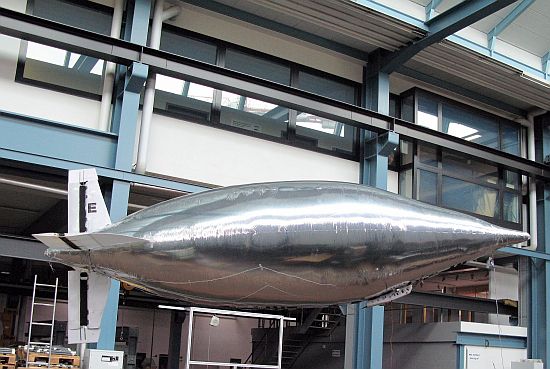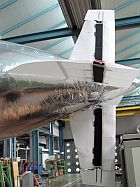Electroactive polymers steer Empa blimp at regatta in Berlin
Empa blimp faces up to international competition
As part of the «Lange Nacht der Wissenschaften» in Berlin on 9 June 2007, an Empa team headed by Silvain Michel will be competing in a regatta with its innovative blimp. As far as the race is concerned, project manager Michel expects to finish somewhere in the middle of the field, but with regard to electroactive polymers (EAPs), the key features of the Empa blimp, his team is well ahead of the international competition. These electrically activated elastic polymer films currently give the blimp its excellent manoeuvrability. In one of the subsequent versions, they should even make it possible for the blimp to «swim» along through the air like a trout.

|
Legend: The Empa blimp during a test flight in Dübendorf. |
||||
|
Speed and manoeuvrability will be in demand during the night of 9 June 2007 in Berlin. The Empa team headed by Silvain Michel from the Mechanical Systems Engineering department will be using its current model of the EAP blimp to take part in an airship regatta as part of the «Lange Nacht der Wissenschaften» («long night of science») – «an event on the boundary between good entertainment and technology transfer», as Michel explains. And even though the «Lange Nacht der Wissenschaften» is aimed primarily at the general public and the regatta attracts mainly airship specialists and inventors as well as scientists, the event is an important occasion for the Empa team. The race provides the opportunity for Empa to present the technology of electroactive polymers (EAPs) and its know-how in this field in a clearly visible way, with the aim of making potential industrial partners aware of Empa. |
||||
|
A further step towards bionic drive systems In the case of the current blimp model, electroactive polymers take care of the altitude and horizontal steering. «With a turning radius of two metres, we have achieved the optimum balance between manoeuvrability and flight stability», says Michel. This has been achieved by fitting the electrically activated elastic polymer films as hinges in the blimp's fin assembly. EAPs are able to convert electric energy directly into mechanical work by expanding their surface area when an electrical voltage is applied. This occurs noiselessly and, with an efficiency rating of up to seventy percent, extremely efficiently with regard to energy use. Thus this technology is suitable not only for steering, but also for providing propulsion, which, in the case of the current model, is supplied by an electric motor-driven propeller. |
|||
|
In future, EAP technology should enable blimps to «swim» through the air like a trout without any propeller. This will be achieved by fusing EAPs with the hull of the blimp, thereby allowing it to move. Experiments by Empa scientists have shown that the «bending rotation stroke», which moves the blimp forward in imitation of the tail movement of the trout, is possible as a result of this. The electrical energy required could come from solar cells on the top of the blimp’s hull. The great advantages of such a bionic drive system would be quietness and economy. «We are hoping these characteristics will open up opportunities for a niche product which could be used, for example, to observe animals or to provide surveillance at concerts or football matches», says Silvain Michel, looking ahead to the future. In order for this to become reality, as the next step, the Empa researchers will have to increase the life of the EAP actuators and improve their reliability. |
||||
|
Further information on the «Lange Nacht der Wissenschaften» (in German) can be found at Further information on Empa’s EAP blimp can be found at Technical information |
||||
|
|||
|
|||

